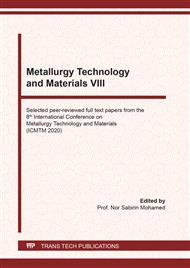[1]
F.X. Yin, Damping behavior characterization of the M2052 alloy aimed for practical application, Acta Metall. Sin. (Chin. Ed.). 39 (2003) 1139-1144.
Google Scholar
[2]
B. Yang, Z. Luo, B. Yuan, J.W. Liu, Y. Gao, High damping of lightweight TiNi-Ti2Ni shape memory composites for wide temperature range usage, J. Mater. Eng. Perform. 26 (2017) 4970-4976.
DOI: 10.1007/s11665-017-2947-5
Google Scholar
[3]
W.B. Liu, N. Li, Z.Y. Zhong, J.Z. Yan, D. Li, Y. Liu, X.C. Zhao, S.Q. Shi, Novel cast-aged MnCuNiFeZnAl alloy with good damping capacity and high usage temperature toward engineering application, Mater. Des. 106 (2016) 45-50.
DOI: 10.1016/j.matdes.2016.05.098
Google Scholar
[4]
I.K. Arhipov, I.S. Golovin, S.A. Golovin, H.R. Sinning, Damping caused by microplasticity in porous 316L steels, Philos. Mag. 85 (2005) 1557-1574.
DOI: 10.1080/14786430412331331952
Google Scholar
[5]
M.A.O. Fox, R.D. Adams, Correlation of the damping capacity of cast iron with its mechanical properties and microstructure, J. Mech. Eng. Sci. 15 (1973) 81-94.
DOI: 10.1243/jmes_jour_1973_015_017_02
Google Scholar
[6]
P. Millet, R. Schaller, W. Benoit, High damping in grey cast iron, J. Phys. Colloq. 46 (1985) 405-408.
DOI: 10.1051/jphyscol:19851091
Google Scholar
[7]
X.B. Liu, S. Takamori, Y. Osawa, The effect of aluminum addition on the damping capacity of cast iron, J. Mater. Sci. Lett. 39 (2004) 6097-6099.
DOI: 10.1023/b:jmsc.0000041710.39427.e0
Google Scholar
[8]
Z.Y. Zhong, W.B. Liu, N. Li, J.Z. Yan, J.W. Xie, D. Li, Y. Liu, X.C. Zhao, S.Q. Shi, Mn segregation dependence of damping capacity of as-cast M2052 alloy, Mater. Sci. Eng. A. 660 (2016) 97-101.
DOI: 10.1016/j.msea.2016.02.084
Google Scholar
[9]
Q.C. Tian, F.X. Yin, T. Sakaguchi, K. Ngai, Reverse transformation behavior of a prestrained MnCu alloy, Acta Mater. 54 (2006) 1805-1813.
DOI: 10.1016/j.actamat.2005.12.007
Google Scholar
[10]
M.G. Kwoon, C.Y. Kang, Correlationship between tensile properties and damping capacity of 316L stainless steel, Korean J. Mater. Res. 24 (2014) 1-5.
DOI: 10.3740/mrsk.2014.24.1.1
Google Scholar
[11]
Z.C. Jiang, S.B. Zhang, Q.C. Tian, P.G. Ji, F.X. Yin, Phenomenological representation of mechanical spectroscopy of high damping MnCuNiFe alloy, Mater. Sci. Technol. 36 (2020) 743-749.
DOI: 10.1080/02670836.2020.1738057
Google Scholar
[12]
Q.C. Tian, F.X. Yin, T. Sakaguchi, K. Nagai, Internal friction behavior of twin boundaries in tensile-deformed Mn-15 at.% Cu alloy, Mater. Sci. Eng. A. 442 (2006) 433-438.
DOI: 10.1016/j.msea.2006.04.135
Google Scholar
[13]
R.H. Shi, F. Lin, N.B. Zeng, F.S. Qin, High damping cast iron and it's damping machanism, J. Shanghai Jiaotong Univ. 25 (1991) 92-98.
Google Scholar
[14]
F.X. Yin, T. Sakaguchi, Q.C. Tian, A. Sakurai, K. Nagai, The twinning microstructure and damping behavior in Mn–30Cu (at%) alloy, Mater. Trans. 46 (2005) 2164-2168.
DOI: 10.2320/matertrans.46.2164
Google Scholar
[15]
R.K. Song, F. Ye, C.X. Yang, S.J. Wu, Effect of alloying elements on microstructure, mechanical and damping properties of Cr-Mn-Fe-V-Cu high-entropy alloys, J. Mater. Sci. Technol. (Shenyang, China). 34 (2018) 48-55.
DOI: 10.1016/j.jmst.2018.02.026
Google Scholar
[16]
Z.C. Jiang, Q.C. Tian, Z.M. Ren, P.G. Ji, J.H. Feng, F.X. Yin, Development and characterization of a MnCu-based high damping alloy plate, IOP Conf. Ser.: Mater. Sci. Eng. 542 (2019) 012020.
DOI: 10.1088/1757-899x/542/1/012020
Google Scholar
[17]
Q.C. Tian, F.X. Yin, T. Sakaguchi, K. Nagai, Internal friction behavior of the reverse martensitic transformation in deformed Mn-Cu alloy, Mater. Sci. Eng. A. 438 (2006) 374-378.
DOI: 10.1016/j.msea.2005.12.058
Google Scholar


